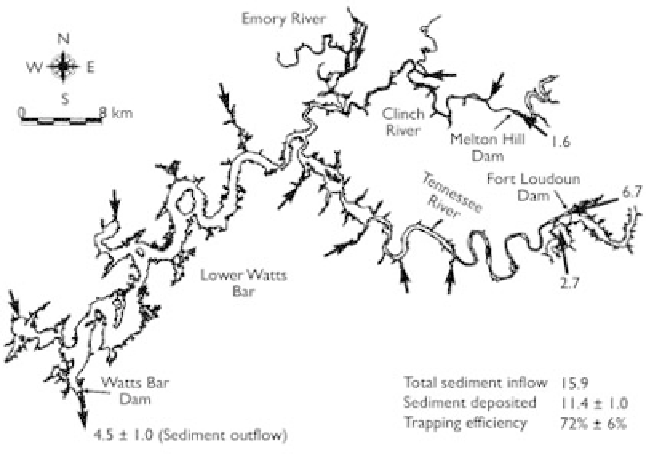Geoscience Reference
In-Depth Information
eroded in flocs. Because there may be hiding, exposure, and armoring among differ-
ent size classes,
E
(
k
b
may vary with size classes; it should be determined using the
entrainment models introduced in Section 2.5 for the non-cohesive size classes and
Eqs. (11.19)-(11.21) for the cohesive size classes.
The fractional bed change is determined by
∂
k
=
z
b
∂
p
m
)
(
1
−
D
bk
−
E
bk
(11.46)
t
The temporal variation of bed-material gradation can be simulated using the
multiple layer model introduced in Section 2.7.2.
The consolidation of non-uniform bed material composed of cohesive and non-
cohesive particles can be determined using Eq. (11.37) or (11.40). However, the
temporal evolution of the dry densities of cohesive size classes should be determined
using Eq. (11.23), (11.24), or a more complex model, while the overall bed dry density
is determined using the Colby formula (2.18) or a similar formula.
The modeling framework introduced above has been applied in many case studies,
including the fine-grained sediment transport in the Watts Bar Reservoir by Ziegler
and Nisbet (1995), the sediment transport dynamics in Thompson Island Pool,
Upper Hudson River by Ziegler
et al
. (2000), and the sedimentation process in the
Danjiangkou Reservoir by Wu and Vieira (2002) shown in Section 5.6. The Watts Bar
Reservoir case is introduced briefly below as an example.
In the Watts Bar Reservoir (Fig. 11.17), suspended sediment particles ranged from
0.001 to 0.25 mm in size, and clay and silt are dominant (about 90%). Two size
Figure 11.17
Sketch of Watts Bar Reservoir (numbers are sediment loads during 1961-1991
in millions of tons) (Ziegler and Nisbet, 1995).


